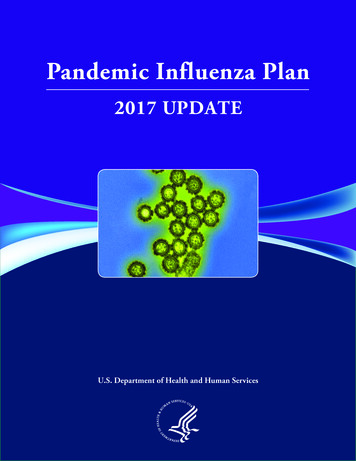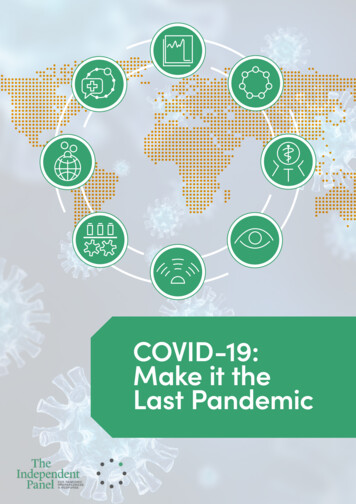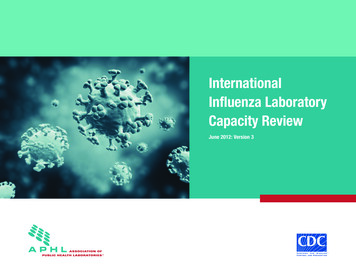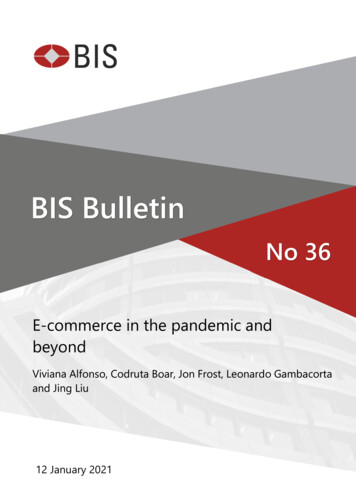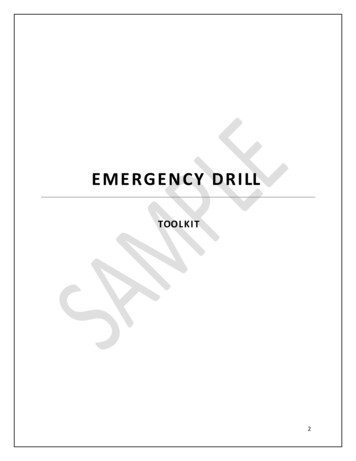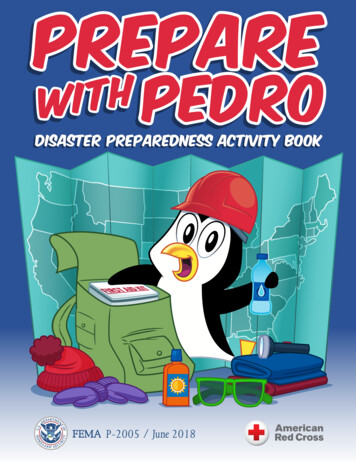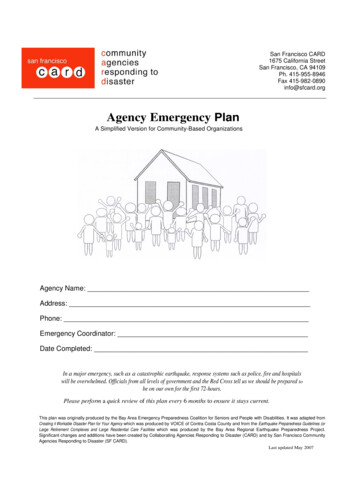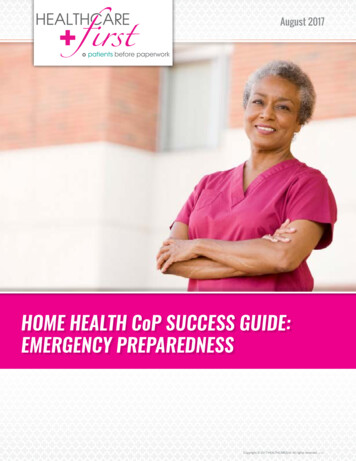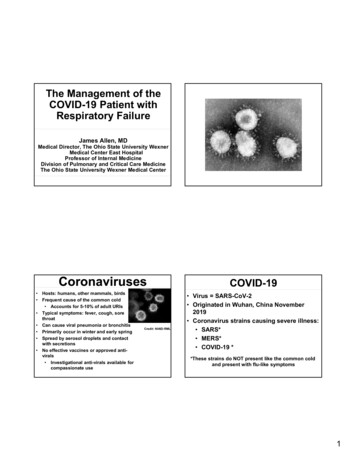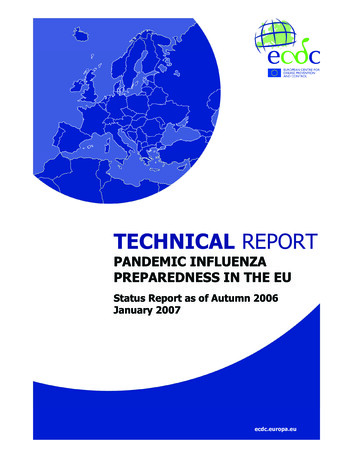
Transcription
TECHNICAL REPORTPANDEMIC INFLUENZAPREPAREDNESS IN THE EUStatus Report as of Autumn 2006January 2007ecdc.europa.eu
Technical Report January 2007Pandemic influenza preparedness in the EUTABLE OF CONTENTSMessage from Commissioner Kyprianou .21. Foreword.32. Executive summary.43. Summary of policy options for further strengthening of preparedness .63.1. Seasonal influenza.63.2. Pandemic preparedness .63.3. Avian influenza.84. Introduction.84.1. Purpose of this document .84.2. Enhancing preparedness in Europe – the process .85. Preparedness status. 105.1. Preparedness at the EU level .115.2. Preparedness at Member State level.125.3. Innovative approaches to preparedness.135.4. Preparedness indicators .146. Policy options for further strengthening of preparedness . 196.1. Seasonal influenza.196.2. Planning, coordination and maintaining essential services .206.3. Surveillance, situation monitoring and assessment .216.4. Prevention and reduction of transmission.226.5. Health service response.236.6. Antivirals for therapy and public health purposes .246.7. Communication .256.8. Interoperability between countries .266.9. Avian influenza.287. Possible next steps . 288. Contributors. 30Pandemic preparedness indicator working group.30Participants 1st Regional Public Health Workshop 18–20 September 2006.30Participants 2nd Regional Public Health Workshop 20–22 September 2006.31Participants Communications Workshop 28–29 September 2006 .319. Annex . 33Preparedness indicators from 25 EU Member States, Norway and Iceland .331
Technical Report January 2007Pandemic influenza preparedness in the EUMESSAGE FROM COMMISSIONER KYPRIANOUAs early as 2001, the European Commission initiated discussions with experts from all overEurope on ways to improve preparedness for an influenza pandemic at EU level. Since then,considerable progress has been made by the EU and its Member States in strengthening theirpreparedness against pandemic influenza.Triggered by the worldwide spread of the avian H5N1 virus, the last two years have seen anintensification of action and all Member States have now developed their preparedness plans.During this period, ECDC, the Commission and the WHO Regional Office for Europe havebeen working closely together in assessing national pandemic preparedness plans throughcountry visits and in organising regional workshops. In November 2005, the Commissionupdated its EU pandemic preparedness plan from March 2004, to take into account theWHO’s revision of pandemic phases and ECDC becoming operational.This report, prepared by ECDC, is a first preparedness review in which 27 countries (25 EUMember States plus Iceland and Norway) participated. A second status report will bedelivered following completion of the assessment of all EU countries (including Bulgaria andRomania) in 2007. This first report is based on many sources including country assessmentvisits, the simulation exercise ‘Common Ground’, the different workshops that have been heldand a questionnaire on the level of preparedness. The report illustrates the substantialprogress made in preparing for a possible pandemic influenza, but at the same time, ithighlights a number of important areas where further work needs to be done.The Commission is committed to foster a continued politicaldrive, so that the necessary time and resources are invested totackle the outstanding issues identified in this report. Thisreport is instrumental in underpinning the importance ofsustained efforts at all operational levels and across allgovernment policies. Only after recognising the task ahead andgiving it the necessary priority, can we reach an adequate levelof pandemic preparedness throughout Europe.Markos KyprianouCommissioner for Health and Consumer Protection2
Technical Report January 2007Pandemic influenza preparedness in the EU1. FOREWORDThe European Commission and Member States had already been working together onpandemic preparedness for several years prior to 2005. However, during the course of that yeara growing perception among policy makers that a pandemic could be nearer than previouslyimagined led to a step change in preparedness efforts in Europe, and indeed internationally.This perception was largely, though not exclusively, driven by the spread of H5N1 avianinfluenza in the world’s bird population and the growing number of human cases of H5N1.Following the template of WHO’s 2005 pandemic plan, ECDC, together with WHO EURO, hadalready developed a methodology for preparedness assessment reviews, which was testedduring joint missions to both EU and non-EU countries and then used to help EU countriesassess their preparedness during 2005 and 2006 by ECDC missions supported by theEuropean Commission. These country visits have been complemented by regional workshopsof EU and EEA/EFTA countries, a ‘Command post’ exercise conducted by the Commission andsimilar national exercises conducted by Member States. The results have been used to keepMarkos Kryprianou, European Commissioner for Health and Consumer Protection, fully andregularly updated on the EU’s state of preparedness.This report is the first formal documentation of the EU’s pandemic preparedness status. Itdescribes the situation as of October 2006. A second status report will be delivered followingcompletion of all EU countries in 2007. The current report shows that the EU countries havemade great progress in preparing for a possible influenza pandemic. However, we cannot becomplacent, as it is clear that there is still much to do. In this regard, the report alsohighlights areas where further progress needs to be made.It is a question of ‘when’ not ‘if’ a pandemic will occur. The cycle of pandemics is over decades,whereas that for seasonal influenza is every winter and needs to be tackled, year in year out. Itis also clear that efforts to combat each are both complementary and inter-related.ECDC will continue to monitor the worldwide influenza situation and react promptly to anythreat to human health in the EU. At the same time we will continuewith our efforts, together with Member States, the Commission andWHO, to strengthen the EU capacities to deal with a potentialinfluenza pandemic. However, as winter approaches, the currentpriority is to increase all our efforts to mitigate the effects of the yearlyoutbreak of seasonal influenza. This regular health threat causes muchillness and thousands of deaths each year on our continent. Tacklingseasonal influenza must therefore continue to be a major priority forECDC. We will continue to support the efforts of the Commission andMember States to cope with this problem and through this to furtherstrengthen the overall European preparedness.Zsuzsanna JakabDirector ECDC3
Technical Report January 2007Pandemic influenza preparedness in the EU2. EXECUTIVE SUMMARYSince 2005, the EU and all its Member States have made considerable progress instrengthening their preparedness against pandemic influenza. The health sectors in allcountries have developed preparedness plans and, at national level, much is being done tomake these plans operational. The challenge now lies in maintaining the momentum andfurther engaging with non-health sector issues, locally and across governments. This reportidentifies a number of other important areas where more work needs to be done. Weestimate that a further two to three years of sustained effort and investment are needed bythe EU and its Member States to achieve the level of preparedness needed to respond well toa pandemic. This means reaching a level of preparedness where one can be confident that: the primary care system will be able to deliver treatment to most of those who need it;the hospital system will be able to deliver acute care to influenza patients as well ascontinuing to provide essential treatment for non-influenza related conditions;essential services like power, food and fuel supplies will continue to function at the locallevel;pandemic vaccine will arrive in the hands of primary care services within six months ofthe start of the pandemic.Twenty-seven countries participated in the preparedness review on which this report is based.Those countries are the first 25 EU Member States, plus Iceland and Norway. A fulldescription of the methodology used is given in Section 5.The major developments in EU preparedness since 2005 identified by the report are asfollows: 4All Member States have national health sector preparedness plans.All have moved on from the stage of preparing plans to making them operational.There is currently a high level of political commitment to the pandemic preparednessprocess across the EU.Officials involved in improving preparedness are aware of the threat and highlymotivated.There has been considerable investment in influenza research at both EU and nationallevel.Some Member States have, or are in the process of building, large stockpiles of antiviraldrugs and all countries have at least some antivirals available.There are systems in place to detect and investigate initial cases of pandemic influenzain most EU countries.There is a growing body of EU-level guidance on pandemic preparedness.A standardised method to enable Member States to assess their preparedness has beendeveloped by the EU in collaboration with WHO.The EU and WHO have held regular Europe-wide pandemic preparedness workshops.An EU-wide pandemic simulation exercise was held in November 2005 involving allMember States.
Technical Report January 2007Pandemic influenza preparedness in the EU Many Member States have developed innovative approaches that other countries canlearn from.Arrangements for a certain level of coordination and prior information oncommunications to the press and the general public have been agreed.The key areas where further work is needed include: Integrated planning across governments. A pandemic will impact on the whole ofgovernment and society, yet there are hardly any published examples of governmentwide pandemic plans in EU countries. Most have essentially health sector plans andmany countries report not yet having business continuity plans for essential publicservices outside the health sector during the sustained stress of a pandemic (e.g.transport, utilities, police, etc).Making plans operational at the local level. Most countries are starting to preparelocal primary care and hospital services, since national preparedness efforts will not beeffective unless the frontline responders are properly prepared. Further work is needed,though, in all countries. Specific issues that need to be addressed include reconfiguringhospitals so they can deliver essential services at the height of a severe pandemic andthe logistics of rapidly distributing antiviral drugs to those who need them, when theyneed them.Interoperability at the national level making sure that national plans and actionswork well together between counties and within countries, undertaking more jointplanning and exercises between neighbouring countries and EU-wide exercises.Stepping up prevention efforts against seasonal influenza. Immunisation and anumber of other public health measures planned for use against pandemic influenzacan also be used against seasonal influenza. The more effective we are in preventingseasonal influenza – and the more used we are to using vaccines and antivirals – thebetter prepared we will be to deal with a pandemic. Just as importantly, betterprevention against seasonal influenza can save thousands of lives each year across theEU.Extending influenza research from basic science to include more operationalresearch into how seasonal influenza spreads and can be prevented as well as morework developing better seasonal and prototype pandemic vaccines. This will all help usto be better prepared for a pandemic.By acting together, Member States and the European Commission, supported by EU Agencieslike ECDC, have made great progress in preparing Europe for a pandemic. A further two tothree years of intense work are needed to finish the job.5
Technical Report January 2007Pandemic influenza preparedness in the EU3. SUMMARY OF POLICY OPTIONS FOR FURTHERSTRENGTHENING OF PREPAREDNESS 1(See also Section 6 for more detail.)3.1. Seasonal influenzaAdopt EU-wide coverage standards based on the goals agreed at the WHO’s WorldHealth Assembly for immunisation in target groups.Ensure that the jointly adopted EU standards for vaccine uptake are met and establishregular monitoring of effectiveness of the vaccine.Adopt communication messages and educational materials concerning seasonalinfluenza for the public and health care workers based on the best examples in MemberStates (MS).Undertake research to improve vaccines, and on mechanisms of influenza transmission,infection control and the effectiveness of public health measures and antivirals. 3.2. Pandemic preparednessPlanning, coordination and maintaining essential servicesDevelop scientifically-based estimates of the numbers of people likely to be affected bypandemic influenza needing medical and social care in the EU.Improve the exchange of planning presumptions between MS.Extend planning and preparations down to regional and local levels and front line staffwithin the MS.Define key target groups for specific preventive messages and protection such ashealth and emergency personnel within the MS.Develop plans for providing surge capacity and coping with staff absenteeism overmonths within the MS.Develop preparedness and business continuity plans across the non-health sectors atnational and regional levels within the MS.Federalised countries to consider how they can best ensure preparedness andinteroperability at regional level where health is a devolved responsibility. Surveillance, situation monitoring and assessmentContinued development, by ECDC and MS, of a schematic plan for surveillance in apandemic, including specific plans for each of the WHO-defined pandemic phases andwith particular attention to pandemic phase 6 including lists of critical information thatwill be needed early in a pandemic. 1Recommendations from workshops of Member State representatives and their subsequent comments.6
Technical Report January 2007Pandemic influenza preparedness in the EU Consideration of how best to set up systems for monitoring health and non-healthsectors within the MS in order to know how these are functioning and whether they arecoping or need more resources.Prevention and reduction of transmission Production of background documentation for inclusion within the menu of personal andpublic health measures that might be expected to reduce transmission in a pandemic.Development of background guidance on the approach to human H5N1 vaccines.Finalised plans for acquiring and delivering pandemic vaccines within the MS.Health service response Integration of pandemic preparedness within primary and secondary health caresystems, training of all health care workers as needed and prioritisation of which corehealth care functions are to continue during a pandemic.Development of practical plans within the MS for maintaining essential hospital servicesin a pandemic including strategies for supplies of antibiotics and other medication.Antivirals for therapy and public health purposes Provision, by ECDC, of background scientific information on the use of antivirals forpublic health purposes.Development and comparison of documentation on the principle of antiviral delivery andsome of the alternative models of delivery being developed in MS.Consideration, by MS together with EMEA and ECDC, of mechanisms to monitoreffectiveness, side-effects and resistance through real time surveillance.Communication Continue the network of EU and Member State communication officers dealing with influenzaand test the systems with exercises as and when issues arise.Foster the development of coordinated messages on seasonal and pandemic influenza.Develop background documentation on preparing material for health care workers.Review communication ‘surge capacity’ for a pandemic within MS.Develop and continue to refine pre-agreed pandemic messages and materials withincountries and between countries where possible, and consider how best to reachminority populations and foreign nationals, including addressing language barriers.Interoperability between countries More systematic discussions between working level policy officials in the MS in order toshare information and learn from each other on planning and policy development.Determine the legal implications of travel restrictions and other interoperability issues.Improved interaction by MS with bordering countries in and outside the EU to discussand agree on a list of issues such as compatible arrangements for primary andsecondary care, common communication strategies and messages, to share triggeringmechanisms and conduct cross-border exercises.7
Technical Report January 2007Pandemic influenza preparedness in the EU3.3. Avian influenzaContinue the joint CMO and CVO meetings but expand discussions to include otherzoonoses as well as avian influenza.Prepare or strengthen common health and veterinary plans or linked plans to developmechanisms in the animal and human health sectors of the MS to timely and efficientlyshare human-avian data. 4. INTRODUCTION4.1. Purpose of this documentThis status report was prepared by the European Centre for Disease Prevention and Control(ECDC) at the request of Health and Protection Commissioner Markos Kyprianou, member ofthe European Commission (EC). The objectives of the report are to:describe the process of strengthening pandemic preparedness in the European Union(EU);summarise the pandemic preparedness status within the EU as at October 2006. This is done by collaboration between the European Commission (EC), other relevantAgencies and the European Centre for Disease Prevention and Control (ECDC), EU MemberStates as well as the European Economic Area countries (EEA) and, where applicable, theWHO Regional Office for Europe (WHO EURO).4.2. Enhancing preparedness in Europe – the processMost European Union (EU) countries have had pandemic plans for many years2 and as earlyas 2001 the European Commission (EC) organised an EU conference on pandemicpreparedness.3 The European Influenza Surveillance Scheme (EISS) has been in place since1999 as one of the EU Communicable Disease Networks following on from an earliersurveillance scheme4,5. However, pandemic planning and preparedness moved up a gearduring the last two years led personally by Commissioner Kyprianou and it has become one ofthe central items on the agenda of the EU EPSCO (Employment, Social Policy, Health andConsumer Affairs) Council meetings between Member State Ministers, as well as in thebilateral discussions with the Ministers. This has been supported by extensive preparatory andfollow up work by the Directorate of Health and Consumer Protection (DG SANCO) in theCommission. The issue took on a new impetus in 2005 when, following initiatives underway2http://www.ecdc.eu.int/Health topics/Pandemic Influenza/Pandemic onal Influenza Pandemic Plans.php.3Conference Preparedness planning in the community: Influenza & other health threats. Brussels, 27 november2001 http://ec.europa.eu/health/ph threats/com/Influenza/influenza conference 1.htm.4http://ec.europa.eu/health/ph threats/com/comm diseases networks en.htm.5European Influenza Surveillance Scheme at http://www.eiss.org/html/introduction.html.8
Technical Report January 2007Pandemic influenza preparedness in the EUby the World Health Assembly, the EC, in collaboration with WHO EURO, organised the firstEuropean pandemic preparedness workshop for all EU, EEA and WHO EURO Member Statesin Luxembourg in March of that year.After ECDC was established in May 2005, the development of pandemic preparednessactivities represented a major investment for ECDC given its limited resources. Initially, ECDCgave priority to the development of strategies to strengthen preparedness at the MemberState and EU levels that went beyond simply reviewing preparedness plans. Drawing on theframework and checklist for pandemic plans published by WHO in early 20056, which werethen supported and supplemented by EU guidelines, ECDC’s strategies included thedevelopment of an assessment tool and indicators to review and monitor the state ofpreparedness, and undertake joint country assessment visits with Member States7. Countryassessment visits, each investing a number of days, were conducted in 2005 and 2006.Another key part of ECDC’s strategy was to identify and share among countries the innovativeapproaches to influenza preparedness in Member States (see section 5.3). During a meetingof the Joint Coordinating Group between ECDC and WHO EURO an agreement was reachedthat ECDC and the Commission would assess pandemic plans within the EU while WHO EUROwould do the same outside the EU using the same or similar methodology and assessmenttools. A joint group working on indicators was established, supported by the Commission (seeSection 8).In addition to the close collaboration between the EC and ECDC and in some aspects of thework with WHO EURO, partnerships with other stakeholders were established, including theEuropean Medicines Agency (EMEA) and the European Food Safety Authority (EFSA).In November 2005, the European Commission published an important communication onpandemic influenza preparedness and response planning in the European Community8, as arevision of a previous EU pandemic influenza preparedness and response plan. TheCommission also developed the concept of a partnership between the public sector andmanufacturers on vaccine development and availability9, and in November 2005 theCommission conducted an EU-wide ‘command post’ simulation exercise on pandemicinfluenza (Exercise ‘Common Ground’) to test communications and preparedness plans andcoordination between the Member States, the EC and Community Agencies such as ECDC andEMEA, as well as with WHO10,11. Through this period the European Commission influenza/WHO CDS CSR GIP 2005 s/influenza/CDS CSR GIP 2005 4.pdf.7ECDC Pandemic preparedness assessment tool. Version September 2006http://www.ecdc.eu.int/Health topics/Pandemic Influenza/Assessment tool.htmlhttp://www.ecdc.eu.int/Health topics/Pandemic Influenza/pdf/Assessment Tool 060913.pdf.8Communication from the Commission to the Council, the European Parliament, the European economic andsocial committee and the committee of the regions on pandemic influenza preparedness and response planning inthe European Community, /en/com/2005/com2005 0607en01.pdf.9http://ec.europa.eu/health/ph threats/com/Influenza/influenza key03 en.pdf.10http://ec.europa.eu/health/ph threats/com/common.pdf.9
Technical Report January 2007Pandemic influenza preparedness in the EUcommitted large funds to undertaking human and animal research especially aiming at thetechnical level and vaccines12.Further European pandemic preparedness workshops were held in October 2005 inCopenhagen and May 2006 in Uppsala13,14. Alternating with the European level workshops,ECDC with the European Commission has started organising smaller, regional level and topicbased workshops in September 2006 to address specific operational issues within and amongMember States. The first two regional preparedness workshops were held in Stockholm inSeptember 2006 for all countries that had not previously been visited by assessment teams,and a communications workshop was held in Athens the same month. The latter leading tothe publication of a communications checklist.15 (See Section 8 for participants).The assessment tool, the mechanism and the preparedness indicators themselves haveevolved considerably during their first year in use. The tool is now used more in a partnershipbetween ECDC and the Member States, rather than an external assessment process. Arevised version of September 2006 is now on the ECDC website.6 The tool includes moredetailed and ‘SMART’16 key indicators that were developed by the working group led by WHOEURO with financial support from the EC (see Section 8 for members). As Member Stateshave improved their preparedness, the tool has moved ahead in its level of detail to guide thenext steps. Sections have been expanded on seasonal influenza immunisation and virologicalservices, interoperability, local preparedness, antiviral strategies, exercises, and avianinfluenza.5. PREPAREDNESS STATUSThis report on EU preparedness status uses information drawn from many sources includingthe country assessment visits, the conclusions of the exercise ‘Common Ground’, theworkshops in September 2006, the Uppsala Workshop and a questionnaire that was sent tothe EU countries17 in September 2006, including the set of 20 preparedness indicators used inthe revised assessment tool6. The country reports are joint products between the EU and the11The main issues identified during the exercise as requiring further work included better addressing theinternational dimension of national preparedness plans, a further development of the EC generic preparednessplan, improving existing communication tools, especially for crisis management and situational awareness, decisionsupport capacity and analytical tools, and to establish adequate command and control centres with liaison systemslinking countries and the European level agencies.12EU Influenza Research ects ala060516/Conclusions Uppsala.pdf.15Outbreak communications during a pandemic: preparedness checklist Sept .16SMART Indicators – indicators that are Specific, Measurable, Achievable, Realistic and Timely.17The European Economic Area countries Iceland and Norway were also included in the assessment.10
Technical Report January 2007Pandemic influenza preparedness in the EUMember States and therefore they can only be released with the agreements of both parties.The individual questionnaires distributed before the regional workshops will not be released.5.1. Preparedness at the EU level5.1.1. Key findingsPandemic preparedness across Europe has considerably strengthened since March 2005, withthe following main achievements and landmarks: The Commission has published background statements on pandemic and genericpreparedness, providing frameworks for EU Member States.EC/ECDC are collaborating with WHO to support avian and pandemic preparedness incountries bordering the EU.EC/ECDC/WHO European pandemic preparedness workshops for the 52 countries of theWHO EURO
influenza in the world’s bird population and the growing number of human cases of H5N1. Following the template of WHO’s 2005 pandemic plan, ECDC, together with WHO EURO, had already developed a methodology for preparedn
